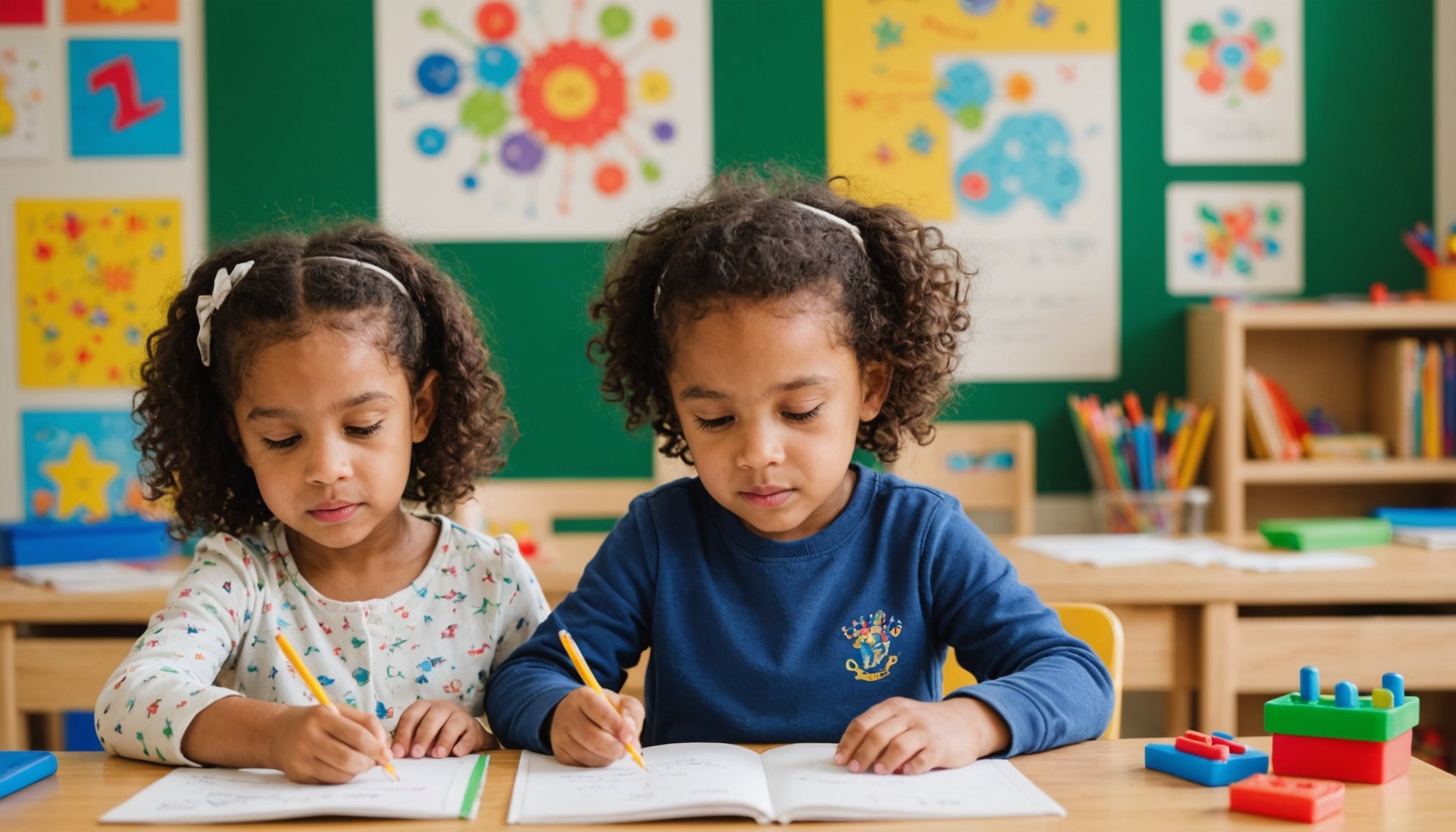Unlocking Potential: How Bilingual Education Supercharges Early Childhood Brain Development
In a world where global connections are increasingly important, the benefits of bilingual education for young children are more significant than ever. Bilingual education is not just about learning a new language; it’s about unlocking a child’s full cognitive, social, and cultural potential. Here’s a deep dive into how bilingual education can supercharge early childhood brain development.
The Cognitive Benefits of Bilingualism
Bilingual education has a profound impact on a child’s cognitive development. Studies have consistently shown that bilingual children exhibit enhanced cognitive skills compared to their monolingual peers.
Also read : Boost Your Mental Wellness: Proven Strategies for Nurturing Robust and Healthy Relationships
Enhanced Executive Functions
Bilingual children develop stronger executive functions, which include problem-solving, multitasking, and focusing attention. This is because their brains are constantly switching between two languages, a process that acts as a daily workout for the brain. As noted in research by Marian & Spivey (2003), “bilingual individuals excel in areas of executive function such as problem-solving, multitasking, and focusing attention”[2].
Improved Memory and Attention
Learning two languages enhances working memory, which is crucial for learning and retention. Bilingual children tend to have better-developed working memories than their monolingual counterparts, aiding in various aspects of academic performance. For instance, a study by Mohades et al. (2012) found that bilingual children have superior working memory skills, which are essential for academic success[2].
Also to discover : Boost Your Wellbeing: Discover How Cold Showers Improve Circulation and Strengthen Immunity
Better Problem-Solving Skills
Bilingual children often have superior problem-solving abilities due to their ability to navigate and negotiate meaning in two different linguistic frameworks. This cognitive flexibility allows them to approach problems from multiple angles, leading to more creative and effective solutions. At Grey Matter Montessori, for example, the International Preschool Curriculum incorporates bilingual learning opportunities that enhance problem-solving skills through engaging and age-appropriate activities[1].
Language Development in Bilingual Children
Contrary to common myths, bilingual children do not suffer from language confusion or delays. Instead, they develop language skills in a unique and enriching way.
Milestones in Bilingual Articulation Development
Bilingual children typically reach speech milestones such as first words and simple phrases around the same age as monolingual children. Here is a comparison of some key milestones:
| Age | Bilingual Children | Monolingual Children | Notes |
|---|---|---|---|
| 12 months | 2-6 words from either/both languages | 2-6 words in one language | Bilinguals might mix languages in phrases |
| 24 months | Combining words from both languages | Combining words in one language | Similar developmental pace, with linguistic mixing in bilinguals |
| 36 months | Differentiating languages, using complex sentences | Using complex sentences in one language | Bilinguals start clearly differentiating languages |
Bilingual children may mix elements from both languages, a sign of linguistic flexibility rather than confusion. This code-switching is a natural part of bilingual language development[2].
Cultural Awareness and Social Benefits
Bilingual education is not just about language; it’s also about cultural awareness and social skills.
Increased Empathy and Cultural Awareness
Learning two languages helps children become more empathetic and culturally aware. They are exposed to different cultural practices, traditions, and perspectives, which enrich their understanding of the world. At Grey Matter Montessori, activities such as celebrating cultural holidays, reading global stories, and participating in arts and crafts that reflect diverse traditions are integral to the curriculum[1].
Adaptability and Creativity
Bilingual children tend to be more adaptable and creative. They learn to think in different ways and see things from various perspectives, which enhances their problem-solving skills and creativity. As Simon Bacher, CEO of Ling, notes, “Learning additional languages is no longer a luxury—it’s a necessity. Multilingual education empowers students to thrive in diverse environments, promotes cognitive development, and ensures better global citizenship”[5].
Practical Strategies for Bilingual Education
Starting a bilingual preschool or implementing bilingual education at home requires careful planning and a consistent approach.
Language Immersion
One effective strategy is language immersion, where children are exposed to both languages throughout the day. This can be achieved through various activities such as:
- Visual Aids: Using posters, flashcards, and labels in both languages to help children learn new vocabulary.
- Daily Routines: Conducting daily routines like greetings, mealtimes, and transitions in both languages.
- Storytelling and Songs: Reading books and singing songs in both languages to expose children to different sounds and rhythms.
- Games and Activities: Playing games and doing activities in both languages to make learning fun and engaging[4].
Curriculum Development
Selecting or creating a bilingual curriculum that is engaging, developmentally appropriate, and promotes language learning in both languages is crucial. Here are some steps to consider:
- Choose a Bilingual Curriculum: Select a curriculum that aligns with your program goals and educational standards.
- Incorporate Cultural Activities: Include activities and lessons that teach children about different cultures and help them immerse themselves in both languages.
- Designated Times: Consider having designated times for each language, such as speaking one language in the morning and the other in the afternoon.
- Regular Assessment: Regularly assess children’s language development in both languages to ensure balance and progress[4].
Long-Term Advantages of Bilingual Education
The benefits of bilingual education extend far beyond early childhood.
Academic Success
Bilingual students often outperform their monolingual peers in academic tests, particularly in reading comprehension and vocabulary tests. This is because learning two languages helps develop important thinking skills that are beneficial across various subjects, including math and science[2].
Career Opportunities
Proficiency in multiple languages is highly valued in many professional fields, including diplomacy, business, and healthcare. In an increasingly globalized world, speaking multiple languages can open doors to endless career opportunities[2].
Resilience Against Cognitive Decline
Research suggests that being bilingual can help delay the onset of dementia and other forms of cognitive decline in older age. This is due to the enhanced cognitive flexibility and executive functions developed through bilingualism[2].
Bilingual education is a powerful tool for unlocking a child’s potential. It enhances cognitive development, promotes cultural awareness, and provides long-term academic and career benefits. By embracing bilingualism, parents and educators can give children the skills they need to thrive in a diverse and interconnected world.
As you consider bilingual education for your child, remember that it’s not just about learning a new language; it’s about fostering a more adaptable, creative, and empathetic individual. With the right approach and support, bilingual children can navigate the complexities of multiple languages with ease, setting them up for a lifetime of success and global citizenship.
Key Takeaways
- Cognitive Benefits: Bilingual education enhances executive functions, improves memory, and boosts problem-solving skills.
- Language Development: Bilingual children develop language skills similarly to monolingual children but with added linguistic flexibility.
- Cultural Awareness: Bilingual education promotes empathy and cultural awareness.
- Practical Strategies: Implement language immersion, develop a bilingual curriculum, and assess language development regularly.
- Long-Term Advantages: Bilingual education leads to academic success, career opportunities, and resilience against cognitive decline.
By understanding and leveraging these benefits, you can help your child unlock their full potential and thrive in a multilingual world.





